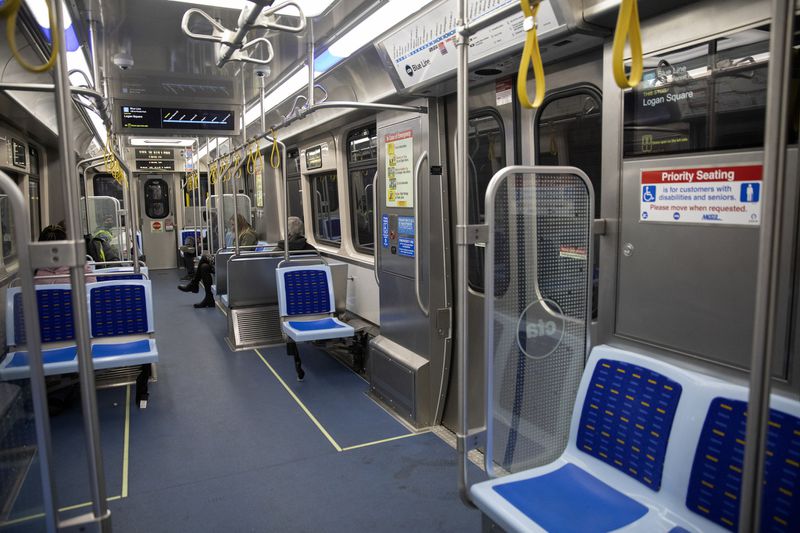Robert Channick | Chicago Tribune
As passengers begin returning to the CTA, they may get a ride on brand-new, made-in-Chicago rail cars.
The Chicago Transit Authority has started in-service testing of its next-generation rail cars — the 7000 series — which were built at a new facility in the Hegewisch neighborhood on the city’s Far Southeast Side. The 10 prototype cars began running Wednesday on the Blue Line to O’Hare International Airport, with plans to rotate to other routes during the year, CTA spokesman Brian Steele said.
The first new cars to hit the CTA tracks in 10 years are part of a $632 million order for 400 rail cars from CRRC Sifang America, a subsidiary of a Chinese rail car manufacturer, which opened its Chicago plant in 2019.
“CTA customers are going to be seeing one of the most modern rail cars in the United States,” Steele said Wednesday.
Riders will be able to identify the cars from a distance, with distinctive blue end caps, new layout of headlights and taillights and a more streamlined look than the rest of the CTA’s aged fleet.

The interior of one of the new 7000-series CTA rail cars on the Blue Line toward Forest Park on April 21, 2021. Distinguishing the 7000-series from the rest of the CTA rail fleet are its bold, blue end caps; new layout of headlights and taillights; as well as a redesigned interior featuring a new seating configuration that includes a mix of forward-facing and aisle-facing seats. (Erin Hooley / Chicago Tribune)
The 380,000-square-foot facility has a myriad of stations for each stage of production – painting, assembly, weighing, and lots and lots of testing. One station is set up to replicate the dimensions of the narrowest places CTA trains navigate.
For passengers, the biggest changes will be inside, with digital video screens at the center of the cars displaying travel information, embedded screens on the sidewalls near the doors, and a new hybrid configuration of forward-facing and aisle-facing seats. Other amenities include brighter LED lighting, a different chime for opening and closing doors, and bright yellow hand grips to grab while hurtling through the city.
The cars also feature a sensing device to adjust the height of the floor to the station platform.
The 10 prototype cars were delivered in August and put into nonpassenger testing throughout the system during the fall and winter, Steele said.
“We ran them through all of the inclement weather we had last winter — heavy snowfalls, subzero temperatures, other precipitation,” Steele said. “The Chicago environment is different clearly than the environment in other cities. That’s why we’re doing such rigorous testing.”
The next and potentially more grueling test is how the cars will fare with passengers aboard. If all goes well, the CTA will green light production on the balance of its initial 400-car order beginning next year, Steele said.
In 2016, CRRC Sifang America was awarded a $1.3 billion contract by the CTA to supply 846 new rail cars over 10 years to replace about half of the agency’s current fleet, some of which dates back more than 30 years. As part of the deal, CRRC Sifang America agreed to build the cars in Chicago, investing $100 million in a new 381,000-square-foot manufacturing facility on 45 acres in the Hegewisch neighborhood.
The plant broke ground in 2017 and began operating in the summer of 2019. It employs more than 100 workers.
Like other mass transit systems, the CTA has struggled during the pandemic, with revenue shortfalls and ridership dropping as much as 80% amid statewide stay-at-home orders last spring. The CTA, which averaged about 1.5 million daily riders before the pandemic, has been hovering at about 500,000 daily passengers this year, Steele said.
Steele said there are signs ridership is increasing, and the agency is hopeful the new cars will be filled with passengers down the line.
“As the city continues to reopen, as offices start welcoming workers back, as people start getting vaccinated and getting back to their normal routine, we do anticipate that ridership numbers will continue to move upward,” Steele said.
Source: Chicago Tribune